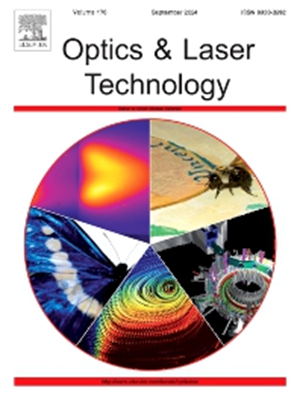通过线-粉喂激光定向能沉积法制造的 TiC/Ti6Al4V 复合材料的微观结构和力学性能
IF 4.6
2区 物理与天体物理
Q1 OPTICS
引用次数: 0
摘要
激光定向能量沉积同时送丝送粉(L-DED-WP)结合了送丝和送粉激光沉积的优点,为制造金属基复合材料提供了一种成本更低、效率更高的新方法。这项研究利用送丝激光沉积和 L-DED-WP 工艺分别成功制备了无缺陷的 Ti6Al4V 合金和 TiC/Ti6Al4V 复合材料。L-DED-WP 工艺通过横向送入 Ti6Al4V 金属丝和同轴送入 TiC 粒子实现,额外的 TiC 含量为 2.93 wt%。分析了 Ti6Al4V 合金和 TiC/Ti6Al4V 复合材料的微观结构特征和机械性能。结果表明,添加 TiC 颗粒后,基体中析出了原位共晶 TiC。由于 TiC 颗粒在凝固过程中沿构建方向分布不均,共晶-TiC 的数量从沉积层底部向中间和顶部区域逐渐增加。相应地,共晶 TiC 的形态在底部呈颗粒状,在中部呈短杆状,而在顶部区域则是颗粒状和短杆状的混合体。此外,共晶-TiC 作为异质成核点,促进了α-Ti 的细化并抑制了α-Ti 的生长,导致α-Ti 的长宽比和纹理强度降低。与 Ti6Al4V 相比,TiC/Ti6Al4V 的屈服强度提高了 11.19%,拉伸强度提高了 11.46%。然而,在拉伸测试过程中,非均匀分布的脆性共晶 TiC 只能通过断裂释放应力,导致伸长率下降 2.57 %。本文章由计算机程序翻译,如有差异,请以英文原文为准。
Microstructure and mechanical properties of TiC/Ti6Al4V composite fabricated by concurrent wire-powder feeding laser-directed energy deposition
Laser-directed energy deposition concurrent wire-powder feeding (L-DED-WP) combines the advantages of wire-feeding and powder-feeding laser deposition, offering a novel method for fabricating metal matrix composites at a lower cost and higher efficiency. This work successfully produced defect-free Ti6Al4V alloy and TiC/Ti6Al4V composites using wire-feeding laser deposition and L-DED-WP, respectively. L-DED-WP process was achieved by lateral feeding of Ti6Al4V wire and coaxial feeding of TiC particles, with an additional TiC content of 2.93 wt%. The microstructure characteristics and mechanical performance of Ti6Al4V alloy and TiC/Ti6Al4V composites were analysed. The results indicate that after adding TiC particles, the in-situ eutectic-TiC precipitated in the matrix. Due to the uneven distribution of TiC particles along the build direction during solidification, the quantity of eutectic-TiC gradually increased from the bottom to the middle and top regions of the deposition layer. Correspondingly, the morphology of eutectic-TiC was granular at the bottom, short rod-like in the middle, and a mix of both granular and short rod-like in the top region. Additionally, the eutectic-TiC served as heterogeneous nucleation sites, promoting the refinement and inhibiting the growth of α-Ti, resulting in a decreased aspect ratio of α-Ti and texture strength. Compared to Ti6Al4V, the yield strength of TiC/Ti6Al4V increased by 11.19 %, while the tensile strength improved by 11.46 %. However, during the tensile testing, the non-uniformly distributed brittle eutectic-TiC could only release stress by fracturing, resulting in a 2.57 % decrease in elongation.
求助全文
通过发布文献求助,成功后即可免费获取论文全文。
去求助
来源期刊
CiteScore
8.50
自引率
10.00%
发文量
1060
审稿时长
3.4 months
期刊介绍:
Optics & Laser Technology aims to provide a vehicle for the publication of a broad range of high quality research and review papers in those fields of scientific and engineering research appertaining to the development and application of the technology of optics and lasers. Papers describing original work in these areas are submitted to rigorous refereeing prior to acceptance for publication.
The scope of Optics & Laser Technology encompasses, but is not restricted to, the following areas:
•development in all types of lasers
•developments in optoelectronic devices and photonics
•developments in new photonics and optical concepts
•developments in conventional optics, optical instruments and components
•techniques of optical metrology, including interferometry and optical fibre sensors
•LIDAR and other non-contact optical measurement techniques, including optical methods in heat and fluid flow
•applications of lasers to materials processing, optical NDT display (including holography) and optical communication
•research and development in the field of laser safety including studies of hazards resulting from the applications of lasers (laser safety, hazards of laser fume)
•developments in optical computing and optical information processing
•developments in new optical materials
•developments in new optical characterization methods and techniques
•developments in quantum optics
•developments in light assisted micro and nanofabrication methods and techniques
•developments in nanophotonics and biophotonics
•developments in imaging processing and systems

 求助内容:
求助内容: 应助结果提醒方式:
应助结果提醒方式:


